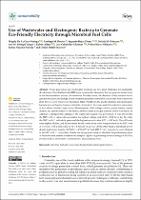| dc.description.abstract | Power generation and wastewater treatment are two great challenges for sustainable development. Microbial fuel cells (MFCs) are a sustainable alternative that can generate bioelectricity in the bioremediation process of wastewater. For this reason, the objective of this research was to generate bioelectricity through double-chamber microbial-combustion cell systems from wastewater from the Covicorti Wastewater Treatment Plant (PTARC) in the anodic chamber and electrogenic bacteria such as Stenotrophomonas maltophilia, Acinetobacter bereziniae, and Achromobacteria xylosoxidans in the cathode chamber, respectively. Measurements of the voltage, current, power density, current density, and optical density of the bacteria and biochemical oxygen demand (BOD) were made. In addition, a metagenomic analysis of the wastewater sample was performed. It was shown that the MFC with A. xylosoxidans generated the highest voltage peak (1.01 ± 0.06 V) on day 24, while the MFC with S. maltophilia generated the highest current value (0.71 ± 0.02 mA). The pH levels were slightly alkaline, and the maximum anodic conductivity value was presented by the MFC with A. cerevisiae, with a peak value of 81 ± 2 mS/cm on day 24. On the other hand, a maximum power density and current density of 195,493 ± 4717 mW/m2 and 4987 A/cm2, respectively, were obtained in the MFC with A. xylosoxidans. Finally, the metagenomic analysis identified the predominant phyla of Proteobacteria present in wastewater samples capable of generating electrical energy as Bacillota, Pseudomonadota, Bacteroidota, Actinomyketone, and Campylobacterota. | es_PE |


